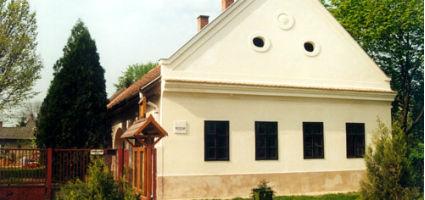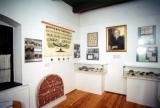2024. April 26. Friday
Andor Semsey Museum - Balmazújváros
 |
Address: 4060, Balmazújváros Debreceni utca 1.
Phone number: (52) 580-640
E-mail: semsey@btelnet.hu
Opening hours: Tue-Sun 10-16
|
A region history collection was established in Balmazújvároson in 1911 - on the initiative of elder Antal Varga headmaster. The collection of about 2300 items - ethnographical, historical relics, archive and private materials - were exhibited in the ground floor rooms of the local council. This museological inheritance was almost totally destroyed by the rowdyism of the Romanians in 1919, and that of the Russians in 1944.
The local council tried to establish a region history museum at the end of the 1950'ies, but this could only be accomplished in the second half of the 1960'ies. In 1964 one of the largest culture houses of the country was opened in Balmazújváros, a big chamber of which was arrenged for a region history exhibition. The founder of the museum was an enthusiastic amateur, József Harangi. The caretaker of the institute was called dr. Péter Fodor.
In 1974, on the initiative of the director of the museum - Imre Dankó - museums were established in several villages of the county. It was then that the local history collection moved to a separate building, too.
The building that gave home to the region history exhibition was built in 1889, by Andor Semsey -great supporter of Hungarian science and culture. It was built to be used as a Roman Catholic school. This school was functioning right up to the beginning of the 1970'ies.
The first permanent exhibition of the settlement was arranged by István Kilián, Hajnalka Csapóné Tábori and Ida Bárdi in 1974. Almost all units of this exhibition reflected the writings and spirit of Péter Veres. Actor Imre Soós and writer Imre Sarkadi were also given olace in the exhibition.
The more than 100-year-old building, built according to the popular baroque style, was wholly renoveted in the beginning of the 1990'ies. A tempral exhibition space, social rooms and a big store were also provided.
Apart from the permanent exhibitions visitors are welcome to about 4-6 tempral exhibitions every year. Relics collected by local citizens and art works of local artists are exhibited.
József Pozsonyi Director
The local council tried to establish a region history museum at the end of the 1950'ies, but this could only be accomplished in the second half of the 1960'ies. In 1964 one of the largest culture houses of the country was opened in Balmazújváros, a big chamber of which was arrenged for a region history exhibition. The founder of the museum was an enthusiastic amateur, József Harangi. The caretaker of the institute was called dr. Péter Fodor.
In 1974, on the initiative of the director of the museum - Imre Dankó - museums were established in several villages of the county. It was then that the local history collection moved to a separate building, too.
The building that gave home to the region history exhibition was built in 1889, by Andor Semsey -great supporter of Hungarian science and culture. It was built to be used as a Roman Catholic school. This school was functioning right up to the beginning of the 1970'ies.
The first permanent exhibition of the settlement was arranged by István Kilián, Hajnalka Csapóné Tábori and Ida Bárdi in 1974. Almost all units of this exhibition reflected the writings and spirit of Péter Veres. Actor Imre Soós and writer Imre Sarkadi were also given olace in the exhibition.
The more than 100-year-old building, built according to the popular baroque style, was wholly renoveted in the beginning of the 1990'ies. A tempral exhibition space, social rooms and a big store were also provided.
Apart from the permanent exhibitions visitors are welcome to about 4-6 tempral exhibitions every year. Relics collected by local citizens and art works of local artists are exhibited.
József Pozsonyi Director
